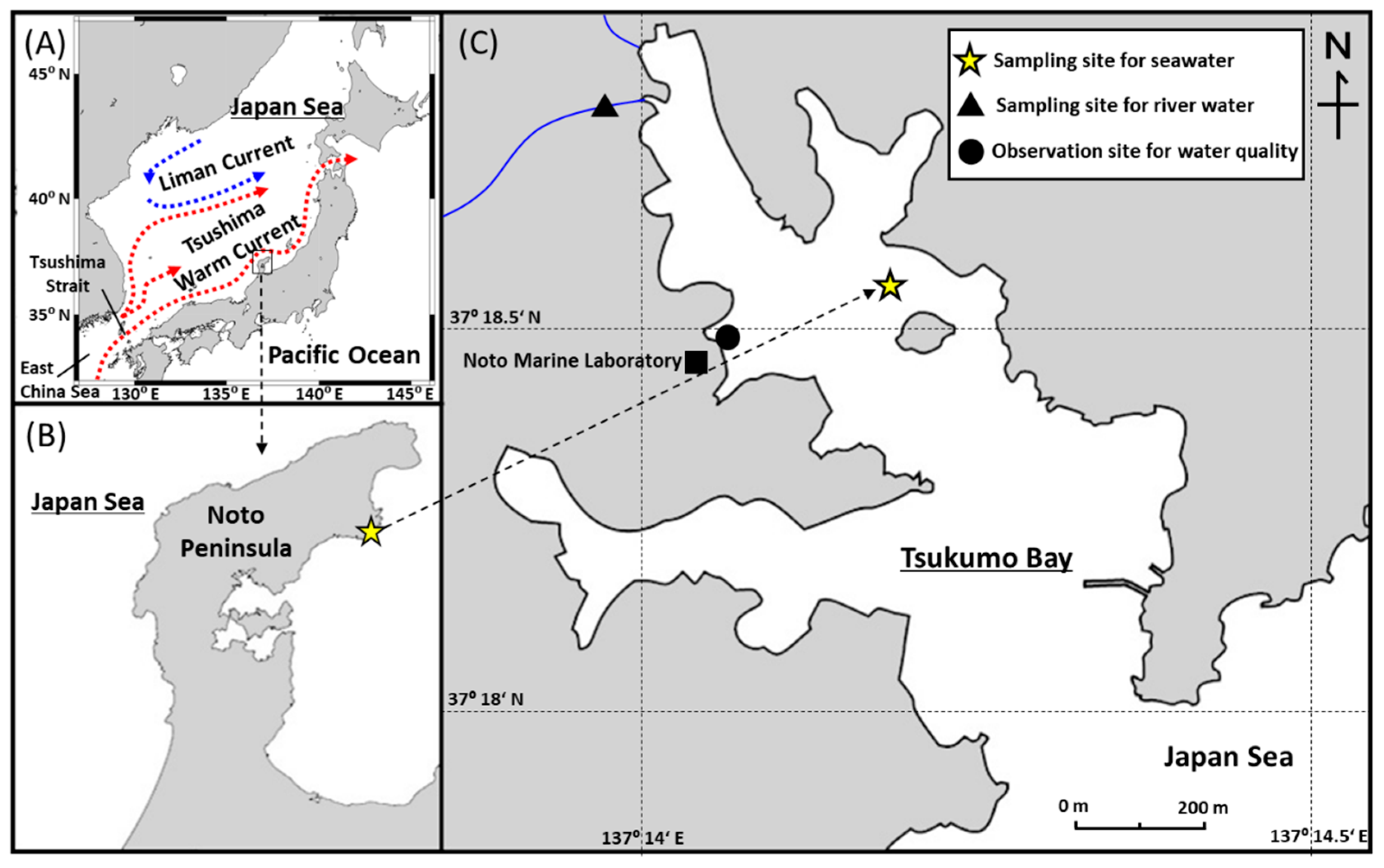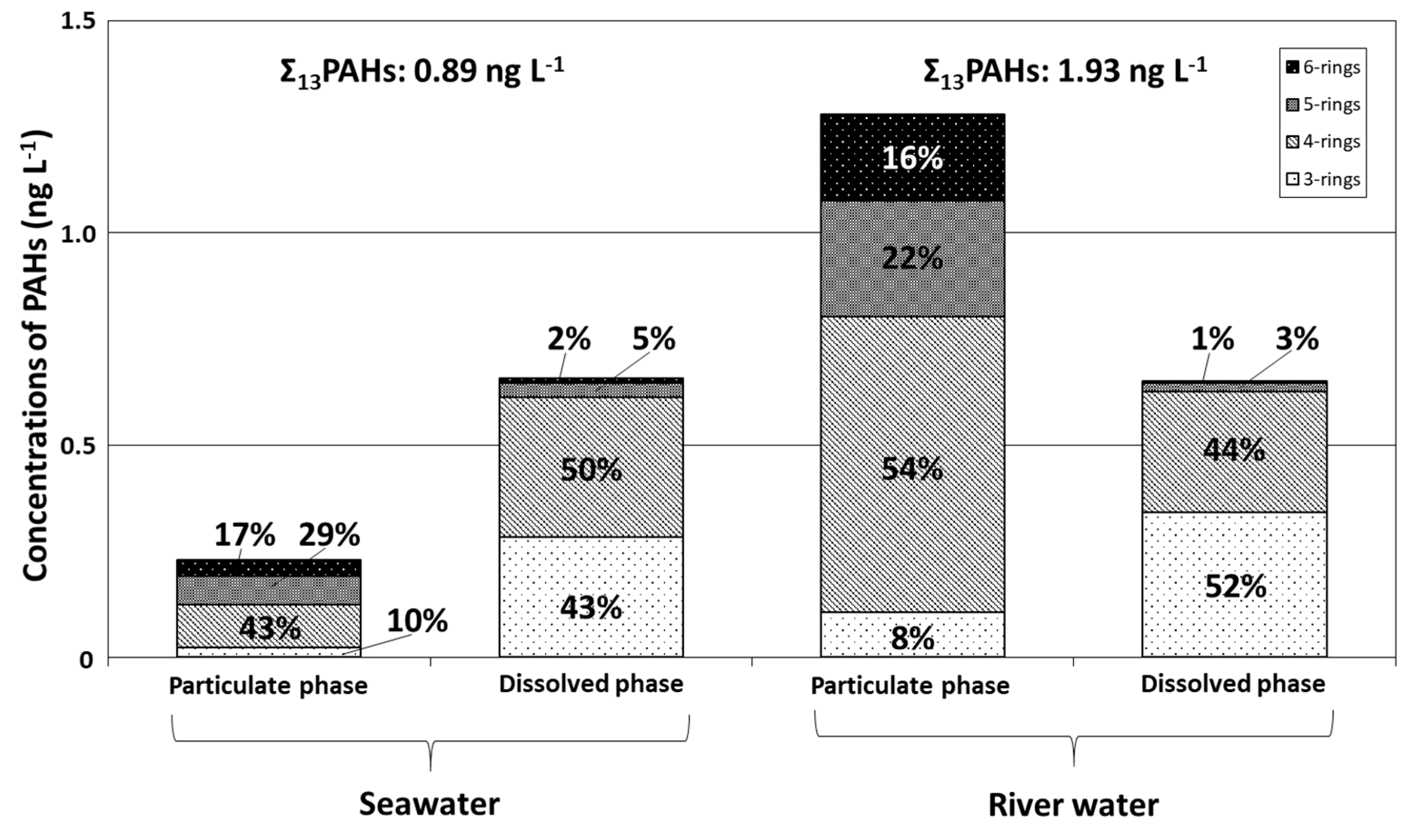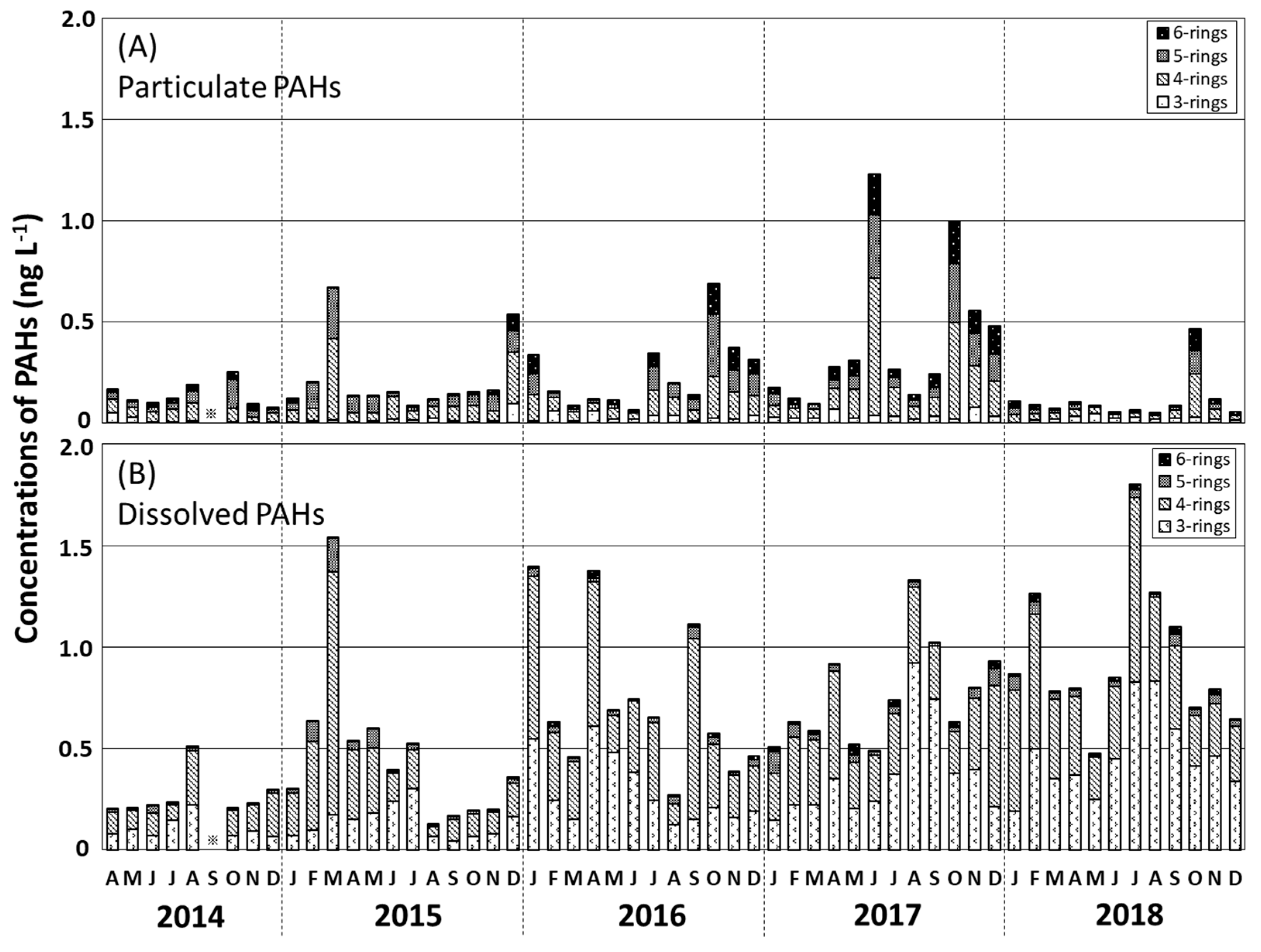RETRACTED: Temporal Variations of Polycyclic Aromatic Hydrocarbons in the Seawater at Tsukumo Bay, Noto Peninsula, Japan, during 2014–2018
Abstract
1. Introduction
2. Materials and Methods
2.1. Study Area and Water Sampling
2.2. Pretreatment and Measurements of PAHs
3. Results and Discussion
3.1. Oceanic Conditions
3.2. PAH Contamination Levels
3.3. PAH Composition
3.4. Primary PAH Contamination Sources
3.5. PAH Variations and Transport Pathways
4. Conclusions
Author Contributions
Funding
Acknowledgments
Conflicts of Interest
References
- Halpern, B.S.; Walbridge, S.; Selkoe, K.A.; Kappel, C.V.; Micheli, F.; D’Agrosa, C.; Bruno, J.F.; Casey, K.S.; Ebert, C.; Fox, H.E. A global map of human impact on marine ecosystems. Science 2008, 319, 948–952. [Google Scholar] [CrossRef] [PubMed]
- Manzetti, S. Polycyclic aromatic hydrocarbons in the environment: Environmental fate and transformation. Polycycl. Aromat. Comp. 2013, 33, 311–330. [Google Scholar] [CrossRef]
- Pashin, Y.V.; Bakhitova, L.M. Mutagenic and carcinogenic properties of polycyclic aromatic hydrocarbons. Environ. Health Persp. 1979, 20, 185–189. [Google Scholar] [CrossRef] [PubMed]
- Shen, H.; Huang, Y.; Wang, R.; Zhu, D.; Li, W.; Shen, G.; Wang, B.; Zhang, Y.; Chen, Y.; Lu, Y.; et al. Global atmospheric emissions of polycyclic aromatic hydrocarbons from 1960 to 2008 and future predictions. Environ. Sci. Technol. 2013, 47, 6415–6424. [Google Scholar] [CrossRef] [PubMed]
- Wan, Y.; Jin, X.; Hu, J.; Jin, F. Trophic dilution of polycyclic aromatic hydrocarbons (PAHs) in a marine food web from Bohai Bay, North China. Environ. Sci. Technol. 2007, 41, 3109–3114. [Google Scholar] [CrossRef] [PubMed]
- Berrojalbiz, N.; Dachs, J.; Ojeda, M.J.; Valle, M.C.; Castro-Jiménez, J.; Wollgast, J.; Ghiani, M.; Hanke, G.; Zaldivar, J.M. Biogeochemical and physical controls on concentrations of polycyclic aromatic hydrocarbons in water and plankton of the Mediterranean and Black Seas. Glob. Biogeochem. Cycles 2011, 25, GB4003. [Google Scholar] [CrossRef]
- Wang, X.; Celander, M.C.; Yin, X.; Zhang, Z.; Chen, Y.; Xu, H.; Yue, X.; Xu, K.; Zhang, X.; Kanchanopas-Barnette, P. PAH and PCB residues and consumption risk assessment in farmed yellow croaker (Larimichthys crocea) from the East China Sea, China. Mar. Pollut. Bull. 2019, 140, 294–300. [Google Scholar] [CrossRef]
- Wang, J.Z.; Guan, Y.F.; Ni, H.G.; Luo, X.L.; Zeng, E.Y. Polycyclic aromatic hydrocarbons in riverine runoff of the Pearl River Delta (China): Concentrations, fluxes, and fate. Environ. Sci. Technol. 2007, 41, 5614–5619. [Google Scholar] [CrossRef]
- Deng, B.; Zhang, J.; Wu, Y. Recent sediment accumulation and carbon burial in the East China Sea. Glob. Biogeochem. Cycles 2006, 20, GB3014. [Google Scholar] [CrossRef]
- Lin, T.; Hu, L.; Guo, Z.; Zhang, G.; Yang, Z. Deposition flues and fate of polycyclic aromatic hydrocarbons in the Yangtze River estuarine-inner shelf in the East China Sea. Glob. Biogeochem. Cycles 2013, 27, 77–87. [Google Scholar] [CrossRef]
- Ya, M.; Wang, X.; Wu, Y.; Li, Y.; Yan, J.; Fang, C.; Zhao, Y.; Qian, R.; Lin, X. Seasonal variation of terrigenous polycyclic aromatic hydrocarbons along the marginal seas of China: Input, phase partitioning, and ocean-current transport. Environ. Sci. Technol. 2017, 51, 9072–9079. [Google Scholar] [CrossRef] [PubMed]
- Ren, H.; Kawagoe, T.; Jia, H.; Endo, H.; Kitazawa, A.; Goto, S.; Hayashi, T. Continuous surface seawater surveillance on polyaromatic hydrocarbons (PAHs) and mutagenicity of East and South China Seas. Estuar. Coast. Shelf Sci. 2010, 86, 395–400. [Google Scholar] [CrossRef]
- Hase, H.; Yoon, J.-H.; Koterayama, W. The current structure of the Tsushima warm current along the Japanese coast. J. Oceanogr. 1999, 55, 217–235. [Google Scholar] [CrossRef]
- Senjyu, T.; Enomoto, H.; Matsuno, T.; Matsui, S. Interannual salinity variations in the Tsushima Strait and its relation to the Changjiang discharge. J. Oceanogr. 2006, 62, 681–692. [Google Scholar] [CrossRef]
- Tang, N.; Hakamata, M.; Sato, K.; Okada, Y.; Yang, X.; Tatematsu, M.; Toriba, A.; Kameda, T.; Hayakawa, K. Atmospheric behaviors of polycyclic aromatic hydrocarbons at a Japanese remote background site, Noto peninsula, from 2004 to 2014. Atmosph. Environ. 2015, 120, 144–151. [Google Scholar] [CrossRef]
- Hayakawa, K.; Makino, F.; Yasuma, M.; Yoshida, S.; Chondo, Y.; Toriba, A.; Kameda, T.; Tang, N.; Kunugi, M.; Nakase, H.; et al. Polycyclic Aromatic Hydrocarbons in Surface Water of the Southeastern Japan Sea. Chem. Pharm. Bull. 2016, 64, 625–631. [Google Scholar] [CrossRef]
- Chizhova, T.; Hayakawa, K.; Tishchenko, P.; Nakase, H.; Koudryashova, Y. Distribution of PAHs in the northwestern part of the Japan Sea. Deep Sea Res. Pt. II 2013, 86–87, 19–24. [Google Scholar] [CrossRef]
- Nagato, E.G.; Makino, F.; Nakase, H.; Yoshida, S.; Hayakawa, K. Improvements in polycyclic aromatic hydrocarbon contamination in the Japan Sea: An interannual survey from 2008 to 2014. Mar. Pollut. Bull. 2019, 138, 333–340. [Google Scholar] [CrossRef]
- Inoue, M.; Tanaka, K.; Watanabe, S.; Kofuji, H.; Yamamoto, M.; Komura, K. Seasonal variation in 228Ra/226Ra ratio within coastal waters of the Sea of Japan: Implications for water circulation patterns in coastal areas. J. Environ. Radioact. 2006, 89, 138–149. [Google Scholar] [CrossRef]
- Japan Meteorological Agency. Available online: http://www.data.jma.go.jp/obd/stats/etrn/index.php (accessed on 5 June 2019).
- Hayakawa, K.; Tang, N.; Nagato, E.G.; Toriba, A.; Sakai, S.; Kano, F.; Goto, S.; Endo, O.; Arashidani, K.; Kakimoto, H. Long term trends in atmospheric concentrations of polycyclic aromatic hydrocarbons and nitropolycyclic aromatic hydrocarbons: A study of Japanese cities from 1997 to 2014. Environ. Pollut. 2018, 233, 474–482. [Google Scholar] [CrossRef]
- Environmental Protection Agency Method 610: Polynuclear Aromatic Hydrocarbons. Available online: https://www.epa.gov/sites/production/files/2015-10/documents/method_610_1984.pdf (accessed on 8 March 2019).
- Inoue, M.; Nakano, Y.; Kiyomoto, Y.; Kofuji, H.; Hamajima, Y.; Yamamoto, M. Seasonal variation of 228Ra/226Ra ratio in surface water from the East China Sea and the Tsushima Strait. J. Oceanogr. 2010, 66, 425–428. [Google Scholar] [CrossRef]
- Kafilzadeh, F. Distribution and sources of polycyclic aromatic hydrocarbons in water and sediments of the Soltan Abad River, Iran. Egypt. J. Aquat. Res. 2015, 41, 227–231. [Google Scholar] [CrossRef]
- Feng, J.; Yang, Z.; Niu, J.; Shen, Z. 0 of polycyclic aromatic hydrocarbons during the resuspension of Yangtze River sediments using a particle entrainment simulator. Environ. Pollut. 2007, 147, 193–200. [Google Scholar] [CrossRef] [PubMed]
- Fu, J.; Suuberg, E.M. Solid vapor pressure for five heavy PAHs via the Knudsen effusion method. J. Chem. Thermodyn. 2011, 43, 1660–1665. [Google Scholar] [CrossRef][Green Version]
- Kim, K.H.; Jahan, S.A.; Kabir, E.; Brown, R.J.C. A review of airborne polycyclic aromatic hydrocarbons (PAHs) and their human health effects. Environ. Internat. 2013, 60, 71–80. [Google Scholar] [CrossRef]
- Colombo, J.C.; Pelletier, E.; Brochu, C.; Khalil, M.; Catoggio, J.A. Determination of hydrocarbon sources using n-alkane and polyaromatic hydrocarbon distribution indexes. Case study: Rio de la Plata Estuary, Argentina. Environ. Sci. Technol. 1989, 23, 888–894. [Google Scholar] [CrossRef]
- Tobiszewski, M.; Namieśnik, J. PAH diagnostic ratios for the identification of pollution emission sources. Environ. Pollut. 2012, 162, 110–119. [Google Scholar] [CrossRef]
- Yunker, M.B.; Macdonald, R.W.; Vingarzan, R.; Mitchell, R.H.; Goyette, D.; Sylvestre, S. PAHs in the Fraser River basin: A critical appraisal of PAH ratios as indicators of PAH source and composition. Org. Geochem. 2002, 33, 489–515. [Google Scholar] [CrossRef]
- Kamens, R.M.; Fulcher, J.N.; Guo, Z. Effects of temperature on wood soot PAH decay in atmospheres with sunlight and low NOx. Atmos. Environ. 1986, 20, 1579–1587. [Google Scholar] [CrossRef]
- Kamens, R.M.; Guo, Z.; Fulcher, J.N.; Bell, D.A. Influence of humidity, sunlight, and temperature on the daytime decay of polyaromatic hydrocarbons on atmospheric soot particles. Environ. Sci. Technol. 1988, 22, 103–108. [Google Scholar] [CrossRef]
- Masclet, P.; Mouvier, G.; Nikolaou, K. Relative decay index and sources of polycyclic aromatic hydrocarbons. Atmos. Environ. 1986, 20, 439–446. [Google Scholar]
- Budzinski, H.; Jones, I.; Bellocq, J.; Piérard, C.; Garrigues, P. Evaluation of sediment contamination by polycyclic aromatic hydrocarbons in the Gironde estuary. Mar. Chem. 1997, 58, 85–97. [Google Scholar] [CrossRef]
- Zhao, X.; Jin, H.; Ji, Z.; Li, D.; Kaw, H.Y.; Chen, J.; Xie, Z.; Zhang, T. PAES and PAHs in the surface sediments of the East China Sea: Occurrence, distribution and influence factors. Sci. Tot. Environ. (in press). [CrossRef] [PubMed]




| Samples | Year | Σ13PAHpart (ng L–1) | Σ13PAHdiss (ng L–1) | Σ13PAHs (ng L–1) | |||||
|---|---|---|---|---|---|---|---|---|---|
| Range | Mean | Fraction (%) | Range | Mean | Fraction (%) | Range | Mean | ||
| Seawater | 2014 | 0.08–0.25 | 0.14 | 35 | 0.20–0.51 | 0.26 | 65 | 0.32–0.70 | 0.40 |
| 2015 | 0.09–0.67 | 0.22 | 32 | 0.13–1.54 | 0.46 | 68 | 0.24–2.20 | 0.68 | |
| 2016 | 0.06–0.69 | 0.24 | 25 | 0.27–1.40 | 0.73 | 75 | 0.46–1.73 | 0.97 | |
| 2017 | 0.09–1.23 | 0.41 | 35 | 0.49–1.33 | 0.76 | 65 | 0.68–1.72 | 1.17 | |
| 2018 | 0.05–0.46 | 0.11 | 11 | 0.47–1.80 | 0.94 | 89 | 0.56–1.86 | 1.06 | |
| 2014–2018 | 0.05–1.23 | 0.23 | 26 | 0.13–1.80 | 0.66 | 74 | 0.24–2.20 | 0.89 | |
| River water | 2019 | – | 1.28 | 66 | – | 0.65 | 34 | – | 1.93 |
| Chemical | Chemical Abbreviation | Seawater | River Water | ||||||||||||||
|---|---|---|---|---|---|---|---|---|---|---|---|---|---|---|---|---|---|
| Rings | Particulate Phase | Dissolved Phase | Particulate Phase | Dissolved Phase | |||||||||||||
| Min. | Max. | Mean | Composition (%) | Min. | Max. | Mean | Composition (%) | Conc. | Composition (%) | Conc. | Composition (%) | ||||||
| Acenaphthene | Ace | 3 | N.D. | 36.4 | 7.0 | 3.1 | 4.4 | 377.9 | 84.4 | 12.7 | 8 | 0.6 | 153.6 | 23.6 | |||
| Fluorene | Fle | 3 | N.D. | 71.3 | 14.4 | 6.3 | 32.4 | 558.2 | 187.8 | 28.2 | 92 | 7.2 | 174.2 | 26.8 | |||
| Anthracene | Ant | 3 | 0.01 | 12.9 | 2.4 | 1.1 | 0.8 | 65.5 | 12.3 | 1.8 | 7 | 0.5 | 13.2 | 2.0 | |||
| Fluoranthene | Flu | 4 | 0.1 | 219.3 | 34.2 | 14.9 | 26.1 | 795.1 | 202.9 | 30.5 | 415 | 32.4 | 123.6 | 19.0 | |||
| Pyrene | Pyr | 4 | 6.2 | 195.3 | 30.4 | 13.2 | 18.8 | 402.2 | 94.3 | 14.2 | 137 | 10.7 | 133.1 | 20.5 | |||
| Benz[a]anthracene | BaA | 4 | 0.2 | 153.3 | 16.2 | 7.0 | 1.0 | 52.7 | 10.5 | 1.6 | 67 | 5.3 | 19.8 | 3.0 | |||
| Chrysene | Chr | 4 | 0.1 | 152.8 | 19.2 | 8.4 | 1.0 | 193.9 | 27.1 | 4.1 | 76 | 5.9 | 8.5 | 1.3 | |||
| Benzo[b]fluoranthene | BbF | 5 | 0.2 | 151.1 | 31.1 | 13.5 | 1.0 | 110.4 | 23.6 | 3.5 | 166 | 13.0 | 15.0 | 2.3 | |||
| Benzo[k]fluoranthene | BkF | 5 | N.D. | 46.7 | 8.7 | 3.8 | 0.8 | 30.6 | 6.0 | 0.9 | 39 | 3.0 | 1.5 | 0.2 | |||
| Benzo[a]pyrene | BaP | 5 | 0.3 | 127.0 | 23.1 | 10.1 | 0.02 | 24.5 | 4.5 | 0.7 | 67 | 5.2 | 3.6 | 0.6 | |||
| Dibenzo[a,h]anthracene | DBA | 5 | 0.1 | 49.4 | 3.7 | 1.6 | N.D. | 7.1 | 1.6 | 0.2 | 1 | 0.1 | 0.5 | 0.1 | |||
| Benzo[ghi]perylene | BgPe | 6 | N.D. | 129.0 | 24.7 | 10.7 | 0.1 | 52.3 | 6.9 | 1.0 | 133 | 10.4 | 2.9 | 0.4 | |||
| Indeno[1,2,3-cd]pyrene | IDP | 6 | 0.3 | 91.9 | 14.7 | 6.4 | 0.2 | 18.7 | 4.2 | 0.6 | 72 | 5.6 | 0.5 | 0.1 | |||
| Samples | Year | Particulate Phase | Dissolved Phase | ||
|---|---|---|---|---|---|
| [Flu] / [Flu + Pyr] | [Flu] / [Flu + Pyr] | ||||
| Range | Mean | Range | Mean | ||
| Seawater | 2014 | 0.43–0.61 | 0.54 | 0.57–0.74 | 0.67 |
| 2015 | 0.39–0.74 | 0.56 | 0.53–0.79 | 0.64 | |
| 2016 | 0.35–0.61 | 0.47 | 0.43–0.84 | 0.63 | |
| 2017 | 0.48–0.65 | 0.56 | 0.63–0.89 | 0.73 | |
| 2018 | 0.46–0.63 | 0.57 | 0.52–0.87 | 0.72 | |
| 2014–2018 | 0.35–0.74 | 0.54 | 0.43–0.89 | 0.68 | |
| River water | 2019 | – | 0.75 | – | 0.48 |
© 2020 by the authors. Licensee MDPI, Basel, Switzerland. This article is an open access article distributed under the terms and conditions of the Creative Commons Attribution (CC BY) license (http://creativecommons.org/licenses/by/4.0/).
Share and Cite
Matsunaka, T.; Nagao, S.; Inoue, M.; Mundo, R.; Tang, N.; Suzuki, N.; Ogiso, S.; Hayakawa, K. RETRACTED: Temporal Variations of Polycyclic Aromatic Hydrocarbons in the Seawater at Tsukumo Bay, Noto Peninsula, Japan, during 2014–2018. Int. J. Environ. Res. Public Health 2020, 17, 873. https://doi.org/10.3390/ijerph17030873
Matsunaka T, Nagao S, Inoue M, Mundo R, Tang N, Suzuki N, Ogiso S, Hayakawa K. RETRACTED: Temporal Variations of Polycyclic Aromatic Hydrocarbons in the Seawater at Tsukumo Bay, Noto Peninsula, Japan, during 2014–2018. International Journal of Environmental Research and Public Health. 2020; 17(3):873. https://doi.org/10.3390/ijerph17030873
Chicago/Turabian StyleMatsunaka, Tetsuya, Seiya Nagao, Mutsuo Inoue, Rodrigo Mundo, Ning Tang, Nobuo Suzuki, Shouzo Ogiso, and Kazuichi Hayakawa. 2020. "RETRACTED: Temporal Variations of Polycyclic Aromatic Hydrocarbons in the Seawater at Tsukumo Bay, Noto Peninsula, Japan, during 2014–2018" International Journal of Environmental Research and Public Health 17, no. 3: 873. https://doi.org/10.3390/ijerph17030873
APA StyleMatsunaka, T., Nagao, S., Inoue, M., Mundo, R., Tang, N., Suzuki, N., Ogiso, S., & Hayakawa, K. (2020). RETRACTED: Temporal Variations of Polycyclic Aromatic Hydrocarbons in the Seawater at Tsukumo Bay, Noto Peninsula, Japan, during 2014–2018. International Journal of Environmental Research and Public Health, 17(3), 873. https://doi.org/10.3390/ijerph17030873





